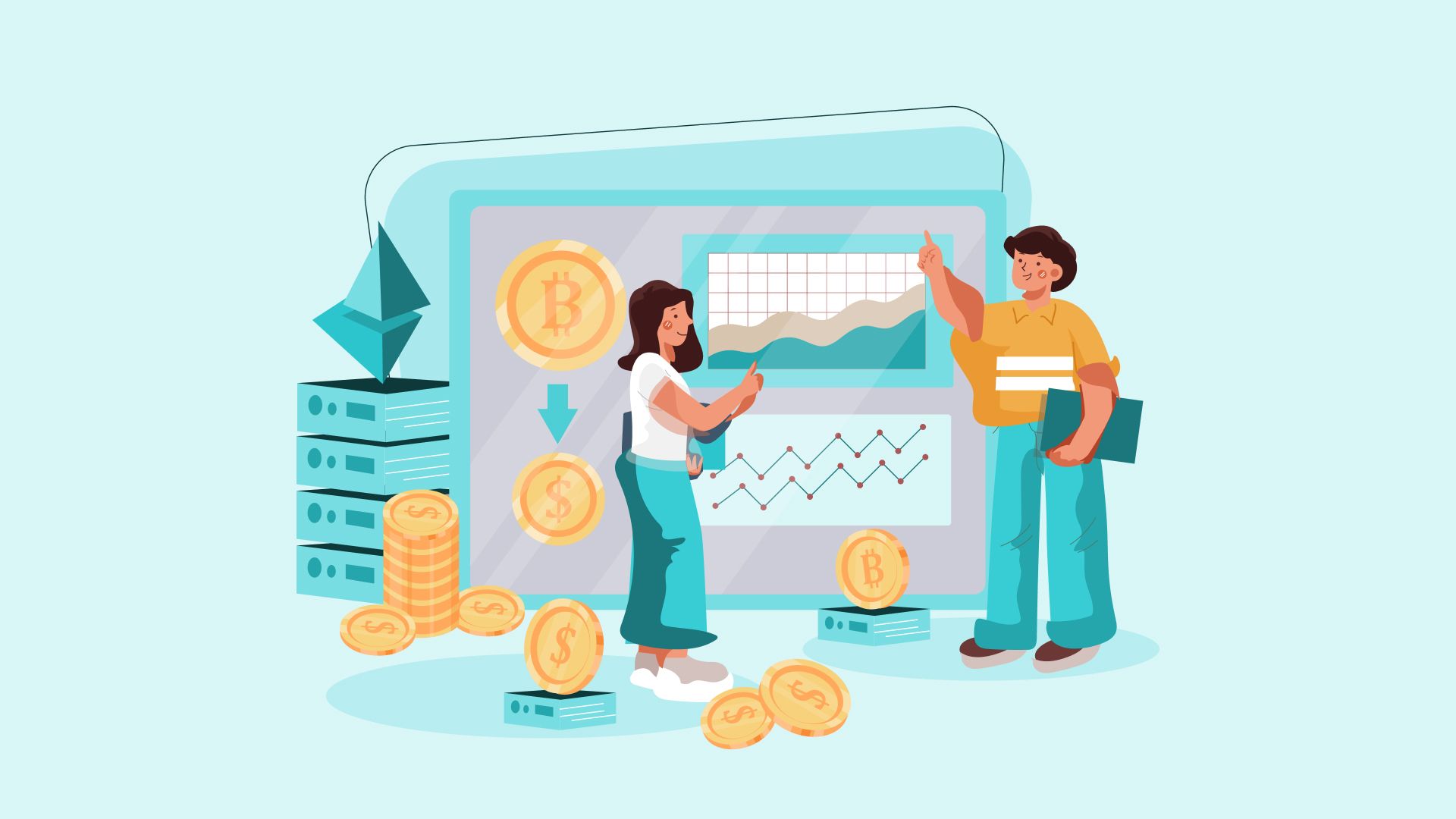An introduction to crypto derivatives
Key takeaways:
- A derivative is a financial contract whose value derives from the performance of an underlying entity.
- Derivatives can trade on an exchange or over-the-counter.
- Four common types of derivatives are futures, options, swaps, and forwards.
- Derivatives are important financial instruments in modern finance and come with advantages and drawbacks.
What is a derivative?
A derivative is a financial contract whose value derives from the performance of an agreed-upon underlying entity. The underlying entity can be commodities, stocks, bonds, interest rates, indexes, currencies, or other derivatives, which adds another layer of complexity for proper valuation. In other words, the price of a derivative is derived from the value and fluctuation of the underlying it is linked to. Derivatives are complex financial instruments that can be used for a few purposes, including hedging (insuring against price movement), speculation (making a financial bet), and leveraging (getting access to additional assets or markets).

A derivative is set between two or more parties that can be traded on an exchange or over-the-counter (off-exchange). In traditional financial markets, most derivatives are traded over-the-counter (OTC), whilst only some derivative contacts, such as futures and options, are traded on specialized exchanges, such as Chicago Mercantile Exchange (CME), the Korea Exchange, and Eurex.
Together with equity (shares or stocks) and debt (bonds, mortgages, etc), derivative is one of the three main categories of financial instruments. The history of derivatives can be traced back to ancient Greek when philosopher Thales entered into a contract transaction of olives and made a profit in the exchange. However, the financial instrument was not widely used until the 1970s, when the introduction of new valuation techniques sparked the rapid development of the derivatives market. Nowadays, the derivative market has far outstripped the equity market and is often estimated at more than $1.2 quadrillion. Some market analysts estimate the derivatives market at more than 10 times the size of the total world gross GDP (https://sciendo.com/pdf/10.1515/seeur-2017-0006).
Types of Derivative Contracts
There are many types of derivatives that can be used for hedging, speculation, and leveraging a position. The derivative market is always growing to fit nearly any need or risk tolerance. Out of the many types of derivatives, the most common types are futures, forwards, swaps, and options.
Futures

Futures is a contract between two parties for the purchase and delivery of a certain asset at a predetermined price on a future date. The parties involved in a futures contract are under the obligation to carry out the contract as agreed. Futures is one of the standardized contracts that can be traded on an exchange. Traders usually use futures to hedge their risk or speculate on the price movement of the underlying asset using leverages.
One of the most heard futures is crude oil futures (OilFut). For example, on Dec. 3rd, 2021, a company buys a futures contract for oil at the price of $67.00 per barrel that expires on Jan. 28th, 2022, because the company needs oil in January, and it worries the oil price might rise when they need the oil. This means, no matter how the crude oil price change, the company will buy the oil at the price of $67.00 on Jan. 28th, 2022. Buying the oil futures hedges the company’s risk because if the oil price rises by the time the company needs it, the company still just needs to pay $67.00 per barrel. Assuming oil price rises to $100 per barrel on Jan. 28th, 2022, the company can accept the delivery of the oil at the price of $67.00. Or, if the company does not need the oil anymore, it can sell the contract before expiry and keep the profits.
In this example, not only the buyer but also the seller was able to hedge the risk. The seller could be an oil company fearing the risk of the oil price drop. By selling a futures contract, it eliminates the risk by being able to sell at a fixed price.
The above example settles with physical delivery. Futures can also be settled in cash, called cash settlement, meaning the gain or loss in the trade is an accounting cash flow to the trader’s account. In the above example, if the company is a trading company, it is unlikely that it would like to make arrangements for the delivery of several barrels of oil. In this case, the company simply speculates on the price movement of the crude oil. If the oil price increases to $100 per barrel on the delivery date, the company takes the profit of $33 (amid fees) per barrel into its account without handling the delivery of the crude oil.
Options

Option, like futures, is also a contract between two parties to buy or sell an asset at a predetermined price (called strike price) on a future date (expiry date). The key difference is that with options, buyers are not obligated to buy the asset, it is just a right. Of course, the right does not come free. Option buyers pay option sellers a fee, called premium, to buy this right. Options are also used to hedge or speculate on the price or fluctuation of the underlying asset.
For example, Alice owns 1 BTC worth $60,000, and she is concerned about the potential risk of holding this BTC and decides to hedge the risk with an options contract. She could spend $200 (premium) buy a put option that gives her the right to sell 1 BTC at $60,000 until a predetermined day in the future. Assume BTC price falls to $50,000 by expiry. It would be wise for Alice to exercise her right to sell the BTC at $60,000. In this case, Alice lost $200 option fees, but prevent the loss of $10,000 from the price drop of BTC.
Alternatively, another trader Bob who does not own BTC believes the BTC price will rise next month. He could spend $100 (premium) to buy a call option that gives him the right to buy BTC at $60,000 before or at expiry. If BTC price rises to $65,000 before expiry, Bob can exercise his right and buy BTC at $60,000, effectively making $4,900 ($5,000-$100) profit.
In Alice’s example, option is a great hedging tool for her to hold her BTC without worrying about the price drop, while for Bob, option helps him to get higher exposure to BTC with a small asset. In both cases, the sellers are obligated to fulfill the contract if the buyers choose to exercise their rights. However, if the buyer does not exercise their rights, options will expire worthlessly, and sellers get to keep the premium.
Forwards

Forwards are customized contracts between two parties to buy or sell an asset at a specified price on a future date. They are similar to the futures in the sense of obligation to carry out the contract as agreed. The most significant difference between the two is that forwards are customized. The buyer and seller are able to customize the size, terms, and settlement process. Forwards are only traded over-the-counter.
As OTC products, forwards carry a greater degree of counterparty risk for both parties as the parties may not be able to live up to obligations outlined in the contract. If one party defaults, the other party may lose the value of its position. Forwards are bound to fewer trading rules and regulations. Being part of the OTC derivatives, forwards are usually traded between banks and other highly sophisticated parties, such as hedge funds.
For example, oil is trading at $67.00 a barrel on Dec. 3rd, 2021. A company wants to buy 1,000 barrels every week for the year at $70.00 per barrel. The exchange won’t have such a product available for the company to buy at his size. It can sign a forward contract with its supplier instead with customized terms, size, and delivery date. No matter how the oil price moves in the next year, the company sticks to $70.00 a barrel to buy 1,000 barrels every week from this supplier.
Swaps

Swaps are contracts between two counterparties to exchange cash flows or financial instruments. Similar to the forwards, they are traded over the counter since they have to be customized to suit the needs and requirements of both parties involved. For example, credit default swaps (CDS), a contract that got popular in the early 2000s and was hit hard during the 2008 financial crisis, is an agreement where buyers pay premiums to the sellers as long as the specified credit event has not accrued. In the event of default, the buyer received compensation from the seller according to the terms of the swap contract.
Another popular swap contract is the interest rate swap. Imagine company A borrows $10 million and pays a variable interest rate that is currently 5%. The company is worried that the interest rate is about to rise. So, it creates a swap with company B, which is willing to exchange the payments of its own fixed-rate loan at 6% for company A’s variable rate loan. That means company A pays 6% interest rate on $10 million and company B pays 5% on $10 million. At the beginning of the swap, company A pays company B the 1% difference between the two swap rates. If the variable interest rate rises to 7%, then company B has to pay company A 1% difference rate on the loan. However, if the interest rate falls to 4%, company A will need to pay a 2% difference to company B on the loan.
Main benefits and disadvantages of Derivatives
Derivatives make a significant impact in modern finance because they provide advantages to the financial markets that other financial instruments don’t.
Benefits
- Hedging risk exposure: Capital protection is quite important, as equally important as capital appreciation most of the time. Since the value of derivatives is linked to the value of the underlying assets, derivatives provide a great way for managing risk exposure. Hedging attempts to alleviate the risk of adverse price movement of the asset by taking an offsetting position in the related asset, such as futures or options market. For example, a trader might purchase an option whose value moves in the opposite direction to the value of the asset. In this way, profits in the derivative contract may offset losses in the underlying, or vice versa.
- High leverage: Derivatives provide high leverages, i.e. The capital needed for taking positions in derivative is generally much less than capital needed to take the position in equity markets. In the case of futures contracts, traditional financial markets usually require 20%-40% of the total contract value, and in crypto, some platforms only require 1% of the contract value, meaning 100x leverage. In options, only the premium amount is required to trade.
- Access to unavailable markets or assets: Derivatives can help users get access to otherwise unavailable assets or markets. For example, by employing interest rate swaps, a company may get a more favorable interest rate compared to the interest rates available from direct borrowing.
- Underlying asset price determination: Derivatives are frequently used to determine the price of the underlying asset. For example, an approximation of a commodity price is known through the spot prices of futures.
- Low transaction cost: The cost of trading in derivatives is lower than that in other securities such as equity. This is beneficial for investors and thus can act as a risk management tool and protection against price fluctuation.
Disadvantage
- Complexity: This is one of the major drawbacks of derivatives as a financial instrument. Investors require sophisticated knowledge and expertise for trading derivatives. Most regular market participants are not aware of the complexity of the derivatives market, thus fostering the scam actors to utilize this weakness and build enticing schemes to take advantage of both the professional and non-professional investors.
- High risk: Derivatives like futures and options are essentially leveraged trading. This brings a huge risk to the traders when markets are volatile. For OTC derivatives, there is a counter-party default possibility. OTC derivatives, compared to exchange derivatives, lack a benchmark for due diligence, increasing the risk of counterparty default.
- Speculative features: Derivatives are widely used for speculation purposes for earning profits. Sometimes huge losses may occur because of the unpredictive and high risky nature of the market.
Discover SynFutures' Crypto Derivatives products: www.synfutures.com/.
Disclaimer: SynFutures Academy does not guarantee the reliability of the site content and shall not be held liable for any errors, omissions, or inaccuracies. The opinions and views expressed in any SynFutures Academy article are solely those of the author(s) and do not reflect the opinions of SynFutures. The SynFutures Academy articles are for educational purposes or information only. SynFutures Academy has no relationship to the projects mentioned in the articles, and there is no endorsement for these projects. The information provided on the site does not constitute an endorsement of any of the products and services discussed or investment, financial, or trading advice. A qualified professional should be consulted prior to making financial decisions.




